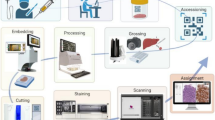Summary
A novel histoprocessing method for paraffin sections is presented in which the combination of vacuum and microwave exposure is the key element. By exploiting the decrease in boiling temperature under vacuum, the liquid molecules in the tissues have been successfully extracted and exchanged at relatively low temperatures during each of the steps from dehydration, clearing, and impregnation. In this vacuum-microwave method, an extremely short time suffices for the preparation of optimal-quality paraffin blocks. No xylene (but isopropanol instead) was used as the intermediate solvent. Thirty biopsies (thickness 2–4 mm) can be processed in 40 min. In addition, this approach can be used to produce large sections of giant blocks (4 × 6 × 1 cm3) which can be easily cut on a routine microtome due to the optimal paraffin impregnation. These giant blocks do not shrink during this vacuum-microwave histoprocessing.
Similar content being viewed by others
References
Bancroft,J. D. &Stevens,A. (1990)Theory and Practice of Histological Techniques, 3rd edn. Edinburgh: Churchill Livingstone.
Boon,M. E.,Kok,L. P. &Ouwerkerk-Noordam,E. (1986) Microwave-stimulated diffusion for fast processing of tissue: reduced dehydrating, clearing, and impregnating times.Histopathology 10, 303–9.
Danielson,C. F.,Block,T.,Brown,G. G. &Summerlin,D. J. (1990) The effect of microwave processing on histochemical staining reactions.J. Histotechnol. 13, 181–3.
Kok,L. P. &Boon,M. E. (1992)Microwave Cookbook for Microscopists - Art and Science of Visualization. Leiden: Coulomb Press Leyden.
Kok,L. P. &Boon,M. E. (1994) Nonchemical dehydration of fixed tissue combining microwaves and vacuum.Eur. J. Morphology 32, 22–30.
Kok,L. P.,Boon,M. E.,Ouwerkerk-Noordam,E. &Gerrits,P. O. (1986) The application of a microwave technique for the preparation of cell blocks from sputum.J. Microsc. 144, 193–9.
Kok,L. P.,Visser,P. E. &Boon,M. E. (1988) Histoprocessing with the microwave oven: an update.Histochem. J. 20, 323–8.
Kok, L. P., Visser, P. E. &Boon, M. E. (1993) How to regulate temperature in the microwave oven. In Proceedings 45th Annual Meeting of the Scandinavian Society for Electron Microscopy (edited byKarlsson, G.), Lund, pp. 9–10.
Kok,L. P.,Visser,P. E. &Boon,M. E. (1994) Programming the microwave oven.J. Neuroscience Meth. 55, 119–24.
Von Seebach,H. B.,Matheis,H. W.,Biewer,E.,Carbon,D.,Eisenbeis,M. &Lahl,F. (1987) Paraffin-Schnelleinbettung zur Routinediagnostik durch Mikrowellen-Stimulation mit einem Küchengerät (in German).Der Pathologe 8, 247–9.
Wong,F. T. S. (1990) Microwave stimulated diffusion method for processing oral mucosal tissue of hamster and human being.J. Histotechnol. 13, 127–9.
Author information
Authors and Affiliations
Rights and permissions
About this article
Cite this article
Kok, L.P., Boon, M.E. Ultrarapid vacuum-microwave histoprocessing. Histochem J 27, 411–419 (1995). https://doi.org/10.1007/BF02389028
Received:
Revised:
Issue Date:
DOI: https://doi.org/10.1007/BF02389028




